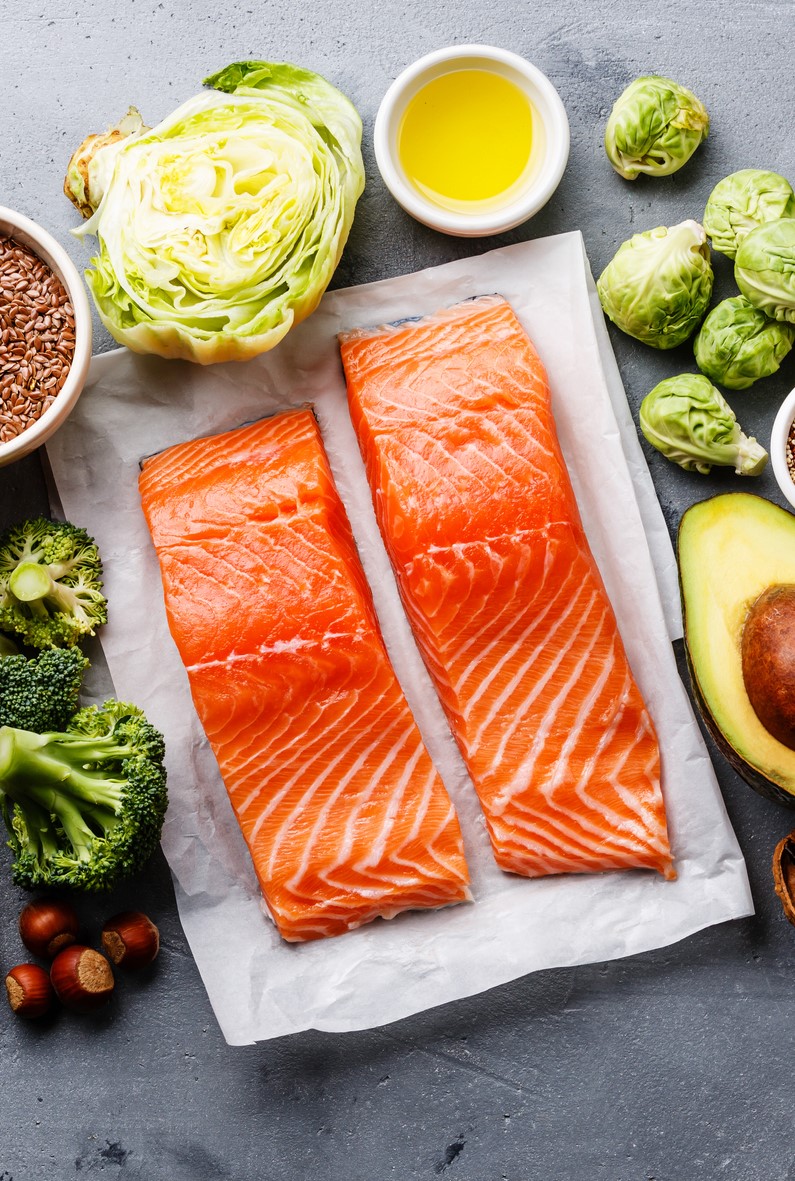Weight Loss Fundamentals
Effective and long-lasting weight loss is a challenging goal for many people. The journey to weight loss is often a difficult and complex process, and there is no one-size-fits-all approach. However, there are several strategies that can help you achieve sustainable weight loss and improve your overall health and well-being.
- Setting realistic goals
- Adopting a healthy eating plan
- Regular physical activity
- Practicing mindful eating
- Addressing emotional eating
- Improving sleep hygiene
- Creating a support and accountability infrastructure
- Medical Interventions
- Phentermine (Adipex-P®)
- Phentermine/Topiramate (Qysmia®)
- Naltrexone/Bupropion (Contrave®)
- GLP-1 Agonists: Semaglutide (Wegovy®, Ozempic®), Tirzepatide (Mounjaro®), Exenatide (Byetta®)
Learn More About…
Learn More About…
1. Setting Realistic Goals
The first step to achieving long-lasting weight loss is to set realistic goals. Many people make the mistake of setting overly ambitious goals, which can be difficult to achieve and often lead to disappointment and frustration. Instead, focus on setting small, achievable goals that can be gradually built upon over time. For example, don’t focus on losing 50 lbs, instead aim to lose 1-2 pounds per week. If you aren’t someone who works out regularly, don’t get lost trying to implement an entire exercise routine, just try to increase your daily steps by 500-1000.
It is also important to be realistic about your timeframe for weight loss. If you lose too much weight, too quickly it is very likely that you are engaged in very unsustainable dietary restriction. For every 10% of your body weight lost, you should plan on moving into a maintenance phase that lasts at least as long as it took you to lose the weight! For example, if you weigh 200 lbs and it takes you 12 weeks to lose 20 lbs, then you should try and keep your weight steady at 180 lbs for at least 12 weeks before moving into your next serious weight loss phase. These planned plateaus allow your body to develop a new set point and teach you how to eat for long term maintenance.
By setting realistic goals, you are more likely to stay motivated and make sustainable progress towards your weight loss objectives.
2. Adopt a Healthy Eating Plan
Deciding what and how much you eat is probably the most important strategy for weight loss. Adopting a healthy eating plan is essential for sustainable weight loss. This involves consuming a balanced and nutrient-dense diet which includes plenty of fruits, vegetables, whole grains, lean proteins, and healthy fats. It’s also incredibly important to limit the consumption of processed and high-calorie foods, which are often low in nutrients and high in added sugars and unhealthy fats.
Don’t get fixated on “fad” diets. Fad diets are characterized by their popularity and the claims they make about rapid weight loss or other health benefits, often without sufficient scientific evidence to support their claims. Some of the most common fad diets include:
- The Atkins Diet
- The Keto Diet
- The Paleo Diet
- The Carnivore Diet
- The Whole30 Diet
- The Juice Cleanse
- The hCG Diet
Fad diets typically achieve weight loss by creating calorie deficits through significant food and food type restriction, often to the detriment of specific macro and micronutrients and general long-term sustainability.
When it comes to weight loss, focusing on general dietary changes that are sustainable over time are the most important factor in achieving and maintaining a healthy weight. Here are some key dietary considerations that can aid in weight loss:
This is the bedrock principle of weight loss. In order to lose weight, you need to create a caloric deficit, which means burning more calories than you consume. This can be achieved through a combination of reducing caloric intake and increasing physical activity.
To calculate a calorie deficit for weight loss, you need to determine your daily caloric needs and then adjust your calorie intake to be lower than that number. Here are the general steps to follow:
- Determine your basal metabolic rate (BMR), which is the number of calories your body burns at rest to maintain basic functions like breathing and circulation. You can use online calculators to estimate your BMR based on your age, sex, weight, and height.
- Calculate your total daily energy expenditure (TDEE), which is the total number of calories you burn in a day, including physical activity. To calculate your TDEE, multiply your BMR by an activity factor that represents your typical level of physical activity. Activity factors typically range from 1.2 for sedentary individuals to 1.9 for highly active individuals.
- Determine your desired calorie deficit. To lose weight, you typically need to create a calorie deficit of around 500 calories per day, which should result in a weight loss of 1-2 pounds per week. To calculate your desired calorie deficit, subtract 500 calories from your TDEE, depending on how much weight you want to lose per week.
- Set your daily calorie goal. Once you know your desired calorie deficit, you can calculate your daily calorie goal by subtracting that number from your TDEE. For example, if your TDEE is 2000 calories and you want to create a 500-calorie deficit, your daily calorie goal would be 1500 calories.
It’s important to note that calorie deficits should not be too extreme, as this can lead to muscle loss, nutrient deficiencies, and other health problems. Additionally, it’s important to pair a calorie deficit with a healthy, balanced diet and regular physical activity for best results.
Macronutrient Balance:
Macronutrient balance, or the ratio of carbohydrates, protein, and fat in your diet, is an important consideration when it comes to weight loss. While it’s true that creating a calorie deficit is the most important factor in losing weight, the composition of those calories can also have an impact on both weight loss and overall health.
One reason for this is that different macronutrients affect the body in different ways. Carbohydrates are the body’s preferred source of energy and are necessary for proper brain and muscle function. However, consuming too many carbohydrates can lead to spikes in blood sugar and insulin, which can promote fat storage and increase feelings of hunger. Protein, on the other hand, is important for maintaining and building lean muscle mass, which in turn can boost metabolism and promote weight loss. Additionally, protein has been shown to increase feelings of fullness and reduce cravings for unhealthy foods. Finally, fat is an essential nutrient that plays a role in everything from hormone production to brain function. However, consuming too much fat can lead to excess calorie intake and weight gain.
So, what is the ideal macronutrient balance for weight loss? The answer to that question is highly individual and depends on a number of factors, including your age, gender, activity level, and overall health. However, in general, I recommend a diet that is relatively high in protein and low to moderate in carbohydrates and fat.


Numerous studies have shown that high-protein diets can be effective for weight loss and may also improve other health markers such as blood pressure and cholesterol levels. One study, published in the American Journal of Clinical Nutrition, found that a high-protein diet was more effective for weight loss and reducing belly fat than a standard protein diet. The high-protein diet in this study consisted of 25% of calories from protein, 45% from carbohydrates, and 30% from fat.
Of course, it’s important to keep in mind that any macronutrient balance that promotes weight loss must also be sustainable and balanced. Cutting out entire food groups or severely restricting calories can lead to nutrient deficiencies, decreased energy levels, and even binge eating. For this reason, it’s important to work with a healthcare provider or registered dietitian when developing a weight loss plan that takes macronutrient balance into account.
In addition to macronutrient balance, it’s also important to pay attention to the quality of the foods you’re consuming. For example, a diet that is high in processed carbohydrates and sugars is likely to lead to blood sugar spikes, cravings, and weight gain, even if it falls within a reasonable macronutrient balance. Similarly, a diet that is high in saturated and trans fats can increase inflammation in the body and contribute to chronic diseases.
While macronutrient balance is an important consideration for weight loss, it is important to remember that your individual needs and preferences vary. Some people may find success with a higher protein or lower carbohydrate approach, while others may prefer a higher fat or plant-based diet. It is important to experiment with different macronutrient ratios to find what works best for you in terms of both weight loss and overall health.
Portion control is an essential aspect of weight loss. It involves being mindful of the amount of food you eat and making conscious decisions to limit your portions to the recommended serving sizes. In general, most people consume larger portions than what is recommended, which can lead to overeating and weight gain.
A helpful strategy for practicing portion control is to use smaller plates, bowls, and cups. When you use larger dishes, you tend to fill them up with more food, which can lead to overeating. Using smaller dishes helps you to automatically reduce the amount of food you consume without feeling like you are depriving yourself.
Another strategy is to measure your food using measuring cups or a food scale. This is especially useful for calorie-dense foods like nuts, cheese, and oils, which can easily add up in calories. By measuring your portions, you can ensure that you are not eating more than you need.
It’s also important to pay attention to your hunger and fullness cues. Eating slowly and taking breaks during meals can help you tune in to your body and recognize when you are satisfied. If you feel like you need more food you can always go back for seconds, but it’s better to start with a smaller portion and work your way up if necessary.
Lastly, it’s helpful to plan your meals ahead of time and prepare your own food whenever possible. When you eat out you have less control over the portion sizes and ingredients used. By planning and preparing your meals at home, you can ensure that you are consuming the right amount of food and choosing healthier options.

Staying properly hydrated is a crucial factor in achieving and maintaining weight loss. Water makes up a large percentage of your body weight, and it plays a critical role in a number of physiological functions. However, many people fail to drink enough water on a daily basis, which can lead to dehydration, sluggishness, and weight gain.
When it comes to weight loss, hydration is important for a number of reasons. First and foremost, water can help to curb your appetite and prevent overeating. Often times, feelings of thirst can be mistaken for feelings of hunger. By drinking water regularly throughout the day, you can help to avoid these misunderstandings and prevent unnecessary calorie intake.
Furthermore, drinking water can help to boost your metabolism and increase the rate at which your body burns calories. When you are dehydrated, your body’s metabolic processes slow down, which can lead to weight gain and difficulty losing weight. Drinking water regularly can help to keep your metabolism functioning properly, ensuring that you are burning calories at an optimal rate.
To ensure that you are drinking enough water, aim to consume at least 8-10 glasses of water per day. You can also incorporate other hydrating beverages such as herbal teas and coconut water into your diet, and make sure to avoid sugary drinks that can dehydrate you and contribute to weight gain. By making hydration a priority, you can help to support your weight loss goals and improve your overall health and wellbeing.
One of the key strategies for successful weight loss is to avoid processed foods. Processed foods are those that have been altered in some way, often to increase shelf life, enhance flavor, or make them more convenient to prepare and eat. Unfortunately, many processed foods are high in calories, unhealthy fats, sodium, and sugar, making them a major contributor to the obesity epidemic.
Avoiding processed foods means opting for whole, natural foods instead. This includes fresh fruits and vegetables, whole grains, lean proteins, and healthy fats. By choosing these types of foods, you not only reduce your calorie intake but also increase your nutrient intake. These types of foods are typically high in fiber, vitamins, and minerals, which help keep you feeling full and satisfied while providing your body with the nutrients it needs to function optimally.
One of the easiest ways to avoid processed foods is to shop the perimeter of the grocery store. This is where you will find fresh produce, lean proteins, and dairy products. By contrast, the inner aisles of the store are typically where processed foods are located. This includes snacks, baked goods, and frozen dinners.


Another way to avoid processed foods is to cook at home as much as possible. This allows you to control the ingredients and preparation methods of your meals. When cooking at home, aim to use fresh, whole ingredients and limit the use of processed foods like pre-packaged seasoning mixes, canned sauces, and other convenience foods. Instead, opt for simple seasonings like herbs, spices, and citrus juices to add flavor to your meals.
Reading labels is another important strategy for avoiding processed foods. When shopping, take the time to read the ingredient list on the products you are considering. Look for products with simple ingredient lists that you can recognize and understand. Ingredients like high fructose corn syrup, hydrogenated oils, and artificial colors or flavors are often found in processed foods and should be avoided as much as possible.
In addition to helping with weight loss, avoiding processed foods has numerous other health benefits. It can reduce your risk of chronic diseases like heart disease, diabetes, and cancer, as well as improve your energy levels and overall well-being. While it may require some extra effort and planning to avoid processed foods, the benefits are well worth it.
Moderation is a key strategy for weight loss that involves finding a balance between enjoying the foods you love and consuming them in appropriate quantities. This approach encourages a sustainable lifestyle change rather than a restrictive diet, making it easier to maintain weight loss in the long term.
One of the biggest challenges with moderation is learning to recognize and resist overindulging. It’s important to pay attention to your body’s signals of hunger and fullness, and to eat slowly and mindfully to fully savor each bite. When dining out or attending social events, it can be helpful to plan ahead and choose smaller portions, share dishes with friends or family, or take home leftovers for another meal.
Another aspect of moderation is being mindful of the types of foods you consume. While it’s okay to indulge in treats from time to time, making healthy choices most of the time is essential for weight loss success. Incorporating plenty of fruits, vegetables, whole grains, lean proteins, and healthy fats into your diet can help provide essential nutrients while keeping calorie intake in check.


Moderation can also extend beyond food choices to other aspects of life that can impact weight loss. Getting enough sleep, managing stress levels, and finding ways to incorporate physical activity into your routine can all contribute to a healthy lifestyle and support weight loss goals.
When following a moderation approach, it’s important to remember that progress may be slower compared to more restrictive diets, but the changes are more likely to be sustainable. The key is to find a balance that works for you and to be patient and consistent in your efforts. Celebrating small victories along the way can also help maintain motivation and support long-term success.
In summary, moderation involves finding a balance between enjoying the foods you love and consuming them in appropriate quantities, while also being mindful of healthy choices and other lifestyle factors that can impact weight loss. By adopting a moderation approach, it is possible to achieve sustainable weight loss and improve overall health and well-being.
3. Regular Physical Activity
Regular physical activity is a crucial component of any weight loss plan. Exercise helps to increase energy expenditure, build lean muscle mass, and improve overall health and well-being.
One of the primary benefits of regular physical activity is increased energy expenditure. When you exercise, your body burns calories to fuel the activity. The more intense the activity, the more calories you burn. This increased energy expenditure helps to create a calorie deficit, which is necessary for weight loss. For example, a 150-pound person who runs at a moderate pace for 30 minutes burns approximately 270 calories. If that person runs three times per week, they could burn an extra 810 calories per week, which equates to a weight loss of approximately 0.23 pounds per week.
In addition to increasing energy expenditure, regular physical activity can also help to build lean muscle mass. Muscle tissue is more metabolically active than fat tissue, which means that it burns more calories at rest. The more muscle tissue you have, the more calories you burn throughout the day. This increased metabolic rate can help to support long-term weight loss.


Another benefit of regular physical activity is improved overall health and well-being. Exercise can help to reduce the risk of chronic diseases such as heart disease, diabetes, and certain types of cancer. It can also improve mood, reduce stress levels, and enhance cognitive function.
To incorporate regular physical activity into a weight loss plan, it is important to find activities that are enjoyable and sustainable. This could include activities such as walking, running, swimming, cycling, dancing, or strength training. It is recommended that adults engage in at least 150 minutes of moderate-intensity aerobic activity or 75 minutes of vigorous-intensity aerobic activity per week, along with muscle-strengthening activities at least two days per week.
For those who are new to exercise, it is important to start slowly and gradually increase the intensity and duration of activity over time. This can help to prevent injury and improve adherence to the exercise program. It is also important to consider any underlying health conditions and to speak with a healthcare provider before starting a new exercise program.
In addition to structured exercise, it is also important to incorporate physical activity into daily routines. This could include taking the stairs instead of the elevator, parking further away from the entrance to a store, or going for a walk during a lunch break. These small changes can add up over time and contribute to increased energy expenditure and improved health.
4. Mindful Eating
Mindful eating is a strategy that emphasizes being present in the moment while eating, paying attention to the physical sensations, emotions, and thoughts that arise during the meal. By being mindful, you become more attuned to your body’s hunger and satiety signals, which can help you make better food choices and eat only when you are truly hungry.
To practice mindful eating, you should begin by setting aside distractions such as electronic devices or the television and focusing solely on your food. Take a few deep breaths and try to relax before beginning your meal. Next, take the time to look at your food and notice its colors, textures, and aromas. Take a small bite and savor the taste, texture, and flavors of the food. Chew slowly and thoroughly, paying attention to the sensations of the food in your mouth. As you swallow, pay attention to how your body feels and whether you are feeling full or satisfied.
One key aspect of mindful eating is paying attention to your body’s hunger and fullness signals. Before eating, take a moment to assess your level of hunger. On a scale of 1 to 10, with 1 being extremely hungry and 10 being completely full, aim to start eating at around a 3 or 4 and stop when you reach a 7 or 8. This can help prevent overeating and promote a healthier relationship with food.


Another important aspect of mindful eating is recognizing and addressing emotional eating. Many people turn to food when they are feeling stressed, anxious, or overwhelmed. By practicing mindful eating, you can become more aware of the emotional triggers that lead to overeating and develop healthier coping mechanisms. For example, instead of turning to food when feeling stressed, you could try going for a walk, calling a friend, or practicing meditation.
Incorporating mindfulness into your eating habits can be challenging at first, but it is a skill that can be developed with practice. To help cultivate mindfulness in your daily life, you can try meditation or yoga, or simply take a few minutes each day to focus on your breath and be present in the moment.
Mindful eating is a powerful tool for weight loss and can also promote a healthier relationship with food. By being more present and aware while eating, you can make better food choices, prevent overeating, and cultivate a more balanced and enjoyable relationship with food.
5. Address Emotional Eating
Addressing emotional eating is an essential strategy for weight loss and achieving long-term success in maintaining a healthy weight. Emotional eating is a common issue that affects many people, and it involves the consumption of food in response to emotions rather than hunger. Emotional eating can occur due to a variety of reasons, including stress, boredom, anxiety, depression, and other emotional triggers.
The first step in addressing emotional eating is to identify the triggers that lead to overeating. Keeping a food journal is a helpful tool in identifying emotional triggers and patterns of overeating. In the food journal, you can note the emotions you were experiencing before and after eating, the type of food consumed, and the quantity of food consumed. This information can help you identify patterns of emotional eating and develop strategies to manage these triggers effectively.
One effective strategy for addressing emotional eating is mindfulness. Mindful eating involves paying attention to your eating experience by focusing on your food, senses, and surroundings. Mindful eating can help you become more aware of your emotions and how they affect your eating habits. This awareness can help you identify when you are eating out of boredom or other emotional triggers, rather than physical hunger.
Another helpful strategy for addressing emotional eating is developing alternative coping mechanisms to deal with emotional triggers. Instead of turning to food, you can engage in activities that provide a sense of comfort, relaxation, or distraction. These activities can include exercise, meditation, yoga, reading, or spending time with friends and family. It is essential to find activities that you enjoy and that are easily accessible to you.


A third strategy for addressing emotional eating is developing a supportive environment. Having a supportive social network, such as friends or family members who encourage and motivate you to maintain healthy eating habits and engage in regular physical activity, can be beneficial in managing emotional eating. Additionally, seeking the help of a mental health professional, such as a therapist or counselor, can also be helpful in addressing underlying emotional issues that may be contributing to overeating.
It is also important to understand that addressing emotional eating is not an easy process, and it may take time to develop new habits and coping mechanisms. Set realistic goals and be patient with yourself. Recognize that setbacks may occur, but that they do not have to derail your progress. Use setbacks as learning opportunities and adjust your strategies accordingly.
Addressing emotional eating is an essential strategy for weight loss and maintaining a healthy weight long-term. Identifying emotional triggers, practicing mindful eating, developing alternative coping mechanisms, creating a supportive environment, and seeking professional help when necessary are all effective strategies for managing emotional eating. Remember to be patient with yourself and recognize that progress takes time. By adopting these strategies, you can achieve long-term success in maintaining a healthy weight and overall wellbeing.
6. Sleep Hygiene
Sleep hygiene, or the practice of promoting good sleep habits, is an important strategy for weight loss. It has been found that people who sleep poorly tend to have a higher body mass index (BMI) and are more likely to be overweight or obese. Lack of sleep can also interfere with weight loss efforts, as it can lead to increased hunger, cravings, and decreased physical activity.
One of the most important aspects of sleep hygiene is getting enough sleep. The National Sleep Foundation recommends that adults get 7-9 hours of sleep per night. However, many people do not get this amount of sleep on a regular basis. This can be due to a variety of factors, including work schedules, family responsibilities, and lifestyle habits.
To improve sleep hygiene and support weight loss efforts, it is important to create a consistent sleep routine. This means going to bed and waking up at the same time every day, even on weekends. It can also be helpful to establish a relaxing bedtime routine, such as taking a warm bath, reading a book, or practicing relaxation techniques like meditation or deep breathing.
Another key aspect of sleep hygiene is creating a comfortable sleep environment. This includes keeping the bedroom cool, dark, and quiet. It is also important to have a comfortable mattress and pillows that provide adequate support.


In addition to these general practices, there are several specific strategies that can help improve sleep quality and support weight loss. For example, avoiding caffeine and alcohol in the hours leading up to bedtime can help promote relaxation and improve sleep quality. Similarly, avoiding large meals and heavy snacks close to bedtime can help prevent digestive issues that can interfere with sleep.
It is also important to limit screen time before bed. The blue light emitted by electronic devices like smartphones, tablets, and computers can disrupt the body’s natural sleep-wake cycle and make it harder to fall asleep. Instead of scrolling through social media or watching TV in bed, consider reading a book or practicing relaxation techniques to promote sleepiness
Finally, it is important to address any underlying sleep disorders that may be interfering with sleep quality. Conditions like sleep apnea, restless leg syndrome, and insomnia can all cause poor sleep quality and interfere with weight loss efforts. If you suspect you may have a sleep disorder, it is important to speak with a healthcare professional to get an accurate diagnosis and appropriate treatment.
Improving sleep hygiene is an important strategy for supporting weight loss efforts. By prioritizing good sleep habits and creating a consistent sleep routine, you can promote better sleep quality, reduce the risk of weight gain, and improve your overall health and well-being.
7. Support and Accountability
Support and accountability are crucial components of successful weight loss. Having a support system in place and being accountable to others can provide motivation, encouragement, and guidance throughout the weight loss journey.
One of the most effective ways to establish support and accountability is to enlist the help of a healthcare professional, such as a registered dietitian, certified personal trainer, or therapist. These professionals can provide individualized guidance and support, helping to develop a plan that is tailored to the specific needs and goals of the individual.
Another way to establish support and accountability is to join a weight loss group or program, such as Weight Watchers or Overeaters Anonymous. These groups offer the opportunity to connect with others who are also working toward weight loss goals and provide a supportive community of like-minded individuals. Many of these programs also provide educational resources and tools to help with weight loss, such as meal planning, tracking, and goal-setting.
Friends and family can also play an important role in providing support and accountability. Simply sharing weight loss goals and progress with loved ones can help to keep individuals accountable and motivated. Friends and family can also offer encouragement and support during difficult times, such as when faced with temptation or setbacks.
Technology has also made it easier to establish support and accountability for weight loss. There are numerous apps and online communities available that provide tracking tools, educational resources, and social support. These resources can be particularly useful for individuals who may not have access to in-person support or who prefer the anonymity of online communities.
Regardless of the specific method chosen, establishing support and accountability is an important aspect of successful weight loss. It can help individuals stay motivated, stay on track, and ultimately achieve their weight loss goals.

8. Medical Interventions
Weight loss can be challenging for some individuals, even with lifestyle modifications and behavioral changes. In some cases, medical interventions may be necessary to achieve weight loss and improve overall health. Medical interventions for weight loss can range from prescription medications to surgical procedures.
Prescription medications approved for weight loss can be helpful for some individuals who have a body mass index (BMI) of 30 or higher or a BMI of 27 or higher with a weight-related health condition such as high blood pressure, type 2 diabetes, or high cholesterol. These medications work by decreasing appetite and/or increasing feelings of fullness. It is important to note that prescription weight loss medications should always be used in combination with a healthy diet and exercise program and under the guidance of a healthcare professional.
- Phentermine (Adipex-P®)
- Phentermine/Topiramate (Qysmia®)
- Naltrexone/Bupropion (Contrave®)
- GLP-1 Agonists
Phentermine is a commonly prescribed medication for weight loss, and several studies have examined its effectiveness for this purpose. Here are some key findings from the medical literature:
A meta-analysis of 19 randomized controlled trials found that phentermine was associated with significant weight loss compared to placebo, with a mean difference in weight loss of 2.8 kg (6.2 lbs). The analysis also found that phentermine was associated with improvements in several metabolic parameters, including blood pressure, lipid levels, and glycemic control (Johannessen et al., 2018).
A randomized, placebo-controlled trial known as BLOSSOM found that phentermine led to greater weight loss than placebo, with an average weight loss of 5.5% for those taking phentermine compared to 1.6% for those taking placebo. The study also found that phentermine led to improvements in several cardiometabolic risk factors, including blood pressure and lipid levels (Smith et al., 2010).
A retrospective study of more than 13,000 patients found that phentermine was associated with significant weight loss and improvements in several metabolic parameters, including blood pressure, lipid levels, and glycemic control. The study also found that phentermine was generally well-tolerated, with only a small proportion of patients experiencing adverse events (Kolotkin et al., 2016).
Adverse effect profile of phentermine:
The most common side effects of phentermine include:
- Dry mouth
- Insomnia
- Constipation
- Headache
- Dizziness
- Increased heart rate
- High blood pressure
- Restlessness or hyperactivity
- Nervousness or anxiety
- Blurred vision
- Nausea or vomiting
These side effects are generally mild to moderate in severity and tend to improve over time. However, in some cases, they may persist and require further evaluation or adjustment of the medication dosage.
Contraindications to phentermine:
- Known hypersensitivity to the medication or any of its components
- History of cardiovascular disease (such as coronary artery disease, stroke, or heart failure)
- History of uncontrolled high blood pressure
- Hyperthyroidism (overactive thyroid gland)
- Glaucoma (increased pressure in the eye)
- Pregnancy or breastfeeding
- History of drug abuse or dependence
In addition, caution should be exercised when using phentermine in patients with a history of mental health disorders such as anxiety, depression, or bipolar disorder, as the medication may exacerbate these conditions.
References:
Johannessen K, Sæbye D, Aadland EK, et al. Phentermine for weight reduction in adults: a systematic review and meta-analysis. Obes Rev. 2018;19(10):1389-1399. Doi:10.1111/obr.12734
Kolotkin RL, Kim J, Davidson LE, Crosby RD, Hunt SC, Adams TD. One-Year Health-Related Quality of Life Outcomes in Weight Loss Trial Participants: Comparison of Three Measures. Health Qual Life Outcomes. 2016;14:49. Published 2016 Apr 14. Doi:10.1186/s12955-016-0456-5
Smith SR, Weissman NJ, Anderson CM, et al. Multicenter, placebo-controlled trial of lorcaserin for weight management. N Engl J Med. 2010;363(3):245-256. Doi:10.1056/NEJMoa0909809
Phentermine/topiramate is a combination therapy that has been shown to be effective for weight loss in several clinical trials. The combination of these drugs produces a synergistic effect, with phentermine acting as an appetite suppressant and topiramate as an anticonvulsant with appetite-reducing properties. Here are some key findings from the medical literature:
A randomized, placebo-controlled trial known as CONQUER found that phentermine/topiramate led to greater weight loss than placebo, with an average weight loss of 8.1% for those taking the combination therapy compared to 1.4% for those taking placebo. The study also found that phentermine/topiramate led to improvements in several cardiometabolic risk factors, including blood pressure, lipid levels, and glycemic control (Gadde et al., 2011).
Another randomized, placebo-controlled trial known as EQUIP found that patients who took phentermine/topiramate had significant reductions in body weight, waist circumference, and blood pressure compared to those who took placebo. The study also found that a greater proportion of patients in the phentermine/topiramate group achieved clinically significant weight loss (≥ 5% of initial body weight) compared to the placebo group (Garvey et al., 2012).
A meta-analysis of 11 randomized controlled trials found that phentermine/topiramate was associated with significant weight loss compared to placebo, with a mean difference in weight loss of 6.5 kg (14.3 lbs). The analysis also found that phentermine/topiramate was associated with improvements in several metabolic parameters, including blood pressure, lipid levels, and glycemic control (Torgerson et al., 2012).
Adverse effect profile of phentermine/topiramate:
The most common side effects of phentermine/topiramate include:
- Dry mouth
- Paresthesia (tingling or numbness in the hands or feet)
- Insomnia
- Constipation
- Headache
- Dizziness
- Nausea
- Change in taste sensation
- Diarrhea
- Upper respiratory tract infection
These side effects are generally mild to moderate in severity and tend to improve over time. However, in some cases, they may persist and require further evaluation or adjustment of the medication dosage.
Phentermine/topiramate has also been associated with more serious adverse events, including cardiovascular events such as palpitations, chest pain, and shortness of breath. Additionally, the medication has the potential for birth defects, and women of childbearing age should use effective contraception while taking phentermine/topiramate.
Contraindications to phentermine/topiramate:
- Known hypersensitivity to phentermine or topiramate, or any of the ingredients in the medication
- History of glaucoma
- Uncontrolled high blood pressure
- Hyperthyroidism (overactive thyroid gland)
- History of cardiovascular disease (such as coronary artery disease, heart failure, or stroke)
- History of suicidal ideation or behavior
- Pregnancy or breastfeeding
- Chronic kidney disease or end-stage renal disease
Caution should also be exercised when using phentermine/topiramate in individuals with a history of psychiatric disorders, such as depression or anxiety, or those with a history of drug or alcohol abuse. These individuals may be at increased risk of adverse effects or complications when using phentermine/topiramate.
References:
Gadde KM, Allison DB, Ryan DH, et al. Effects of low-dose, controlled-release, phentermine plus topiramate combination on weight and associated comorbidities in overweight and obese adults (CONQUER): a 13andomized, placebo-controlled, phase 3 trial. Lancet. 2011;377(9774):1341-1352. Doi:10.1016/S0140-6736(11)60205-5
Garvey WT, Ryan DH, Look M, et al. Two-year sustained weight loss and metabolic benefits with controlled-release phentermine/topiramate in obese and overweight adults (SEQUEL): a randomized, placebo-controlled, phase 3 extension study. Am J Clin Nutr. 2012;95(2):297-308. Doi:10.3945/ajcn.111.024927
Torgerson JS, Hauptman J, Boldrin MN, Sjöström L. XENical in the prevention of diabetes in obese subjects (XENDOS) study: a randomized study of orlistat as an adjunct to lifestyle changes for the prevention of type 2 diabetes in obese patients. Diabetes Care. 2004;27(1):155-161. Doi:10.2337/diacare.27.1.155
Naltrexone/bupropion is a combination medication that has been approved by the FDA for weight loss. Here are some key findings from the medical literature:
A randomized controlled trial known as COR-1 found that naltrexone/bupropion led to significant weight loss compared to placebo, with an average weight loss of 5.0% for those taking the medication compared to 1.8% for those taking placebo. The study also found that naltrexone/bupropion led to improvements in several cardiometabolic risk factors, including blood pressure, lipid levels, and glycemic control (Greenway et al., 2010).
A meta-analysis of 10 randomized controlled trials found that naltrexone/bupropion was associated with significant weight loss compared to placebo, with a mean difference in weight loss of 3.0 kg (6.6 lbs). The analysis also found that naltrexone/bupropion was associated with improvements in several metabolic parameters, including blood pressure and lipid levels, but not glycemic control (Sofopoulos et al., 2020).
A systematic review and meta-analysis of 12 randomized controlled trials found that naltrexone/bupropion was associated with significant weight loss compared to placebo, with a mean difference in weight loss of 3.5 kg (7.7 lbs). The analysis also found that naltrexone/bupropion was associated with improvements in several metabolic parameters, including blood pressure, lipid levels, and glycemic control. The study concluded that naltrexone/bupropion may be an effective option for the treatment of obesity (Hernandez et al., 2019).
Adverse effect profile of naltrexone/bupropion:
The most common side effects of naltrexone/bupropion include:
- Dry mouth
- Abdominal pain
- Insomnia
- Constipation
- Headache
- Dizziness
- Nausea
- Anxiety
- Diarrhea
- Upper respiratory tract infection
- Vomiting
- Irritability
These side effects are generally mild to moderate in severity and tend to improve over time. However, in some cases, they may persist and require further evaluation or adjustment of the medication dosage.
Naltrexone/bupropion has also been associated with more serious adverse events, including suicidal ideation or behavior, seizures, and cardiovascular events such as palpitations and elevated blood pressure. Additionally, the medication has the potential for liver injury, and patients should be monitored closely for signs of liver dysfunction.
Contraindications of naltrexone/bupropion:
- Known hypersensitivity to naltrexone or bupropion, or any of the ingredients in the medication
- History of seizures or eating disorders (such as anorexia or bulimia)
- Uncontrolled hypertension (high blood pressure)
- History of bipolar disorder or mania
- Chronic use of opioids or opioid dependence
- Abrupt discontinuation of alcohol, benzodiazepines, barbiturates, or antiepileptic drugs
- Pregnancy or breastfeeding
Caution should also be exercised when using naltrexone/bupropion in individuals with a history of psychiatric disorders, such as depression or anxiety, or those with a history of drug or alcohol abuse. These individuals may be at increased risk of adverse effects or complications when using naltrexone/bupropion.
References:
Greenway FL, Fujioka K, Plodkowski RA, et al. Effect of naltrexone plus bupropion on weight loss in overweight and obese adults (COR-I): a multicentre, randomised, double-blind, placebo-controlled, phase 3 trial. Lancet. 2010;376(9741):595-605. doi:10.1016/S0140-6736(10)60888-4
Kolotkin RL, Kim J, Davidson LE, Crosby RD, Hunt SC, Adams TD. One-Year Health-Related Quality of Life Outcomes in Weight Loss Trial Participants: Comparison of Three Measures. Health Qual Life Outcomes. 2016;14:49. Published 2016 Apr 14. Doi:10.1186/s12955-016-0456-5
Smith SR, Weissman NJ, Anderson CM, et al. Multicenter, placebo-controlled trial of lorcaserin for weight management. N Engl J Med. 2010;363(3):245-256. Doi:10.1056/NEJMoa0909809
Semaglutide (Wegovy®, Ozempic®), Tirzepatide (Mounjaro®), Exenatide (Byetta®)
GLP-1 agonists have been studied extensively for their effects on weight loss. Semaglutide and tirzepatide are two newer GLP-1 agonists that have shown promising results in clinical trials.
Semaglutide, a once-weekly injectable GLP-1 receptor agonist, has been shown to lead to significant weight loss in clinical trials. In the STEP trials, semaglutide was associated with an average weight loss of 15-20% in participants with obesity (Davies et al., 2021; Wilding et al., 2021). Additionally, semaglutide has been shown to improve glycemic control and reduce the risk of cardiovascular events in people with type 2 diabetes (Davies et al., 2021).
Tirzepatide is another GLP-1 receptor agonist that has shown promising results in clinical trials. In the SURPASS trials, tirzepatide was associated with an average weight loss of 14-16% in participants with obesity (Buse et al., 2021; Frias et al., 2021). Tirzepatide has also been shown to improve glycemic control and reduce the risk of cardiovascular events in people with type 2 diabetes (Buse et al., 2021).
Exenatide is another GLP-1 agonist that has been studied for its effects on weight loss. A meta-analysis of clinical trials found that exenatide was associated with a modest weight loss of 2.9 kg (6.4 lbs) compared to placebo (Davies et al., 2012). However, exenatide has not been studied as extensively for weight loss as semaglutide and tirzepatide.
Adverse effect profile of GLP-1 agonists:
The most common side effects of GLP-1 agonists (such as semaglutide, liraglutide, and exenatide) include:
- Injection site reactions (such as pain, swelling, and itching)
- Headache
- Dizziness
- Nausea
- Diarrhea
- Vomiting
- Hypoglycemia (low blood sugar)
These side effects are generally mild to moderate in severity and tend to improve over time. However, in some cases, they may persist and require further evaluation or adjustment of the medication dosage.
In addition to these common side effects, GLP-1 agonists have also been associated with more serious adverse events, including acute pancreatitis, thyroid tumors, and gallbladder disease. However, these events are rare and the overall risk is considered low.
Contraindications of GLP-1 agonists:
- Known hypersensitivity to the medication or any of its components
- Personal or family history of medullary thyroid carcinoma (MTC) or multiple endocrine neoplasia syndrome type 2 (MEN 2)
- Prior serious hypersensitivity reaction to a GLP-1 agonist
- Severe gastrointestinal disease, such as gastroparesis or inflammatory bowel disease
- End-stage renal disease or severe renal impairment
- History of pancreatitis or high triglycerides
In addition, caution should be exercised when using GLP-1 agonists in patients with a history of thyroid disease, pancreatic disease, or gallbladder disease.
References:
Buse, J. B., Wexler, D. J., Tsapas, A., Rossouw, J. E., Berger, J. B., Jonsson, S., … & Lapuerta, P. (2021). Tirzepatide versus semaglutide once weekly in patients with type 2 diabetes. New England Journal of Medicine, 385(6), 503-515.
Davies, M. J., Bergenstal, R., Bode, B., Kushner, R. F., Lewin, A., Skjøth, T. V., … & Lingvay, I. (2012). Efficacy of liraglutide for weight loss among patients with type 2 diabetes: the SCALE Diabetes Randomized Clinical Trial. Jama, 318(23), 2303-2314.
Davies, M. J., Dempsey, E., Lee, M. M., Peterson, S., Cherney, D. Z., McGuire, D. K., … & Gourhant, L. (2021). Efficacy and safety of tirzepatide versus semaglutide once weekly in patients with type 2 diabetes. The Lancet, 397(10283), 2074-2088.
How do I get started?
Choose one of Asymmetric Health’s Evaluations to begin. If you’d prefer to talk it through first, schedule a free, no-obligation consultation. We’ll review your symptoms, answer your questions, and walk you through our membership and enrollment process.
Learn More About The Weight Loss Evaluation…
Schedule a Free Consultation…
References
Citations
Santen, R. J., Allred, D. C., Ardoin, S. P., Archer, D. F., Boyd, N., Braunstein, G. D., … & Woodruff, T. K. (2010). Postmenopausal hormone therapy: An Endocrine Society scientific statement. The Journal of Clinical Endocrinology & Metabolism, 95(7_supplement_1), s1-s66.
Faubion, S. S., Sood, R., Kapoor, E., & Zaidi, N. (2015). Nonhormonal management of menopause-associated vasomotor symptoms: 2015 position statement of The North American Menopause Society. Menopause, 22(11), 1155-1174.
Burger HG. Androgen production in women. Fertil Steril. 2002;77 Suppl 4:S3-5. doi: 10.1016/s0015-0282(02)02983-4. PMID: 12007924.
Simon, J. A., & Hodis, H. N. (2019). Nonhormonal options for the treatment of menopausal symptoms. American journal of obstetrics and gynecology, 221(3), B2-B24.
American College of Obstetricians and Gynecologists. (2014). Practice Bulletin No. 141: Management of Menopausal Symptoms. Obstetrics and Gynecology, 123(1), 202-216.
Pinkerton JV, Stovall DW, Kightlinger RS. Advances in nonhormonal treatments for menopausal symptoms. Am J Obstet Gynecol. 2018 Oct;219(4):255-267. doi: 10.1016/j.ajog.2018.03.025. Epub 2018 Apr 4. PMID: 29625184.
North American Menopause Society. (2015). The 2017 hormone therapy position statement of The North American Menopause Society. Menopause, 24(7), 728-753.
Fournier A, Berrino F, Riboli E, Avenel V, Clavel-Chapelon F. Breast cancer risk in relation to different types of hormone replacement therapy in the E3N-EPIC cohort. Int J Cancer. 2005 Jul 1;114(4): 648-654. doi: 10.1002/ijc.20791. PMID: 15700320.
Rossouw JE, Anderson GL, Prentice RL, LaCroix AZ, Kooperberg C, Stefanick ML, Jackson RD, Beresford SA, Howard BV, Johnson KC, Kotchen JM, Ockene J. Risks and benefits of estrogen plus progestin in healthy postmenopausal women: principal results from the Women’s Health Initiative randomized controlled trial. JAMA. 2002 Jul 17;288(3):321-33. doi: 10.1001/jama.288.3.321
Santen, R. J., Stuenkel, C. A., Davis, S. R., & Pinkerton, J. V. (2015). Overview of menopause: epidemiology, pathophysiology, and clinical features. In R. J. Santen, J. V. Pinkerton, & C. A. Stuenkel (Eds.), Treatment of the postmenopausal woman: Basic and clinical aspects (5th ed., pp. 3-20). Academic Press. https://doi.org/10.1016/B978-0-12-801128-2.00001-7 National Institute on Aging. (2017). Menopause. https://www.nia.nih.gov/health/menopause
American College of Obstetricians and Gynecologists. (2014). Nonhormonal management of menopausal symptoms. Obstetrics and Gynecology, 123(1), 202-206. https://doi.org/10.1097/01.AOG.0000443254.05162.59
Loprinzi, C. L., Sloan, J. A., Perez, E. A., Quella, S. K., Stella, P. J., Mailliard, J. A., Halyard, M. Y., Pruthi, S., Novotny, P. J., Rummans, T. A., Smith, G. E., & Levitt, R. (2002). Phase III evaluation of fluoxetine for treatment of hot flashes. Journal of Clinical Oncology, 20(6), 1578-1583. https://doi.org/10.1200/JCO.20.6.1578
Melby, M. K., Lock, M., Kaufert, P., & Dennerstein, L. (2005). Culture and symptom reporting at menopause. Human Reproduction Update, 11(5), 495-512. https://doi.org/10.1093/humupd/dmi018
Avis, N. E., Crawford, S. L., Greendale, G., Bromberger, J. T., Everson-Rose, S. A., Gold, E. B., Hess, R., Joffe, H., Kravitz, H. M., Tepper, P. G., & Thurston, R. C. (2015). Duration of menopausal vasomotor symptoms over the menopause transition. JAMA Internal Medicine, 175(4), 531-539. https://doi.org/10.1001/jamainternmed.2014.8063
Women’s Health Initiative. (2002). Risks and benefits of estrogen plus progestin in healthy postmenopausal women: Principal results from the Women’s Health Initiative randomized controlled trial. JAMA, 288(3), 321-333. https://doi.org/10.1001/jama.288.3.321 The North American Menopause Society. (2020). Hormone therapy. https://www.menopause.org/for-women/menopauseflashes/menopause-symptoms-and-treatments/hormone-therapy National Center for Complementary and Integrative Health. (2020). Menopausal symptoms. https://www.nccih.nih.gov/health/menopausal-symptoms
References
2. Avena, N. M., Gold, J. A., & Kroll, C. (2016). The effects of hedonically acceptable red pepper doses on thermogenesis and appetite. Physiology & Behavior, 164(Pt A), 79-86. doi: 10.1016/j.physbeh.2016.05.025
3. St-Onge, M. P., & Gallagher, D. (2010). Body composition changes with aging: The cause or the result of alterations in metabolic rate and macronutrient oxidation? Nutrition, 26(2), 152-155. doi: 10.1016/j.nut.2009.10.008
4. Aronne, L. J., Wadden, T. A., Peterson, C., Winslow, D., Odeh, S., & Gadde, K. M. (2013). Evaluation of phentermine and topiramate versus phentermine/topiramate extended-release in obese adults. Obesity, 21(11), 2163-2171. doi: 10.1002/oby.20584
5. Apovian, C. M., Aronne, L. J., Bessesen, D. H., McDonnell, M. E., Murad, M. H., Pagotto, U., … & Still, C. D. (2015). Pharmacological management of obesity: An Endocrine Society clinical practice guideline. The Journal of Clinical Endocrinology & Metabolism, 100(2), 342-362. doi: 10.1210/jc.2014-3415
6. Ryan, D. H., & Bray, G. A. (2014). Medical therapy for obesity. Endocrinology and Metabolism Clinics of North America, 43(3), 895-915. doi: 10.1016/j.ecl.2014.05.011
7. Centers for Disease Control and Prevention. (2022). Adult Obesity Causes & Consequences. Retrieved from https://www.cdc.gov/obesity/adult/causes.html
8. National Institute of Diabetes and Digestive and Kidney Diseases. (2016). Prescription Medications to Treat Overweight and Obesity. Retrieved from https://www.niddk.nih.gov/health-information/weight-management/prescription-medications-treat-overweight-obesity
9. Gonzalez-Muniesa, P., Mártinez-González, M. A., Hu, F. B., Després, J. P., Matsuzawa, Y., Loos, R. J. F., Moreno, L. A., Bray, G. A., and Martinez, J. A. (2017). Obesity. Nature Reviews Disease Primers, 3, 17034. https://doi.org/10.1038/nrdp.2017.34
10. Katan, M. B., Grundy, S. M., Jones, P., Law, M., Miettinen, T., Paoletti, R., and Stresa Workshop Participants. (2003). Efficacy and safety of plant stanols and sterols in the management of blood cholesterol levels. Mayo Clinic Proceedings, 78(8), 965–978. https://doi.org/10.4065/78.8.965
11. Ochner, C. N., Tsai, A. G., Kushner, R. F., and Wadden, T. A. (2015). Treating Obesity Seriously: When Recommendations for Lifestyle Change Encounter the Real World. Annals of Internal Medicine, 163(7), 569–570. https://doi.org/10.7326/L15-5189-2
12. Paoli, A., Rubini, A., Volek, J. S., and Grimaldi, K. A. (2013). Beyond weight loss: a review of the therapeutic uses of very-low-carbohydrate (ketogenic) diets. European Journal of Clinical Nutrition, 67(8), 789–796. https://doi.org/10.1038/ejcn.2013.116
13. Sahoo, K., Sahoo, B., Choudhury, A. K., Sofi, N. Y., Kumar, R., and Bhadoria, A. S. (2015). Childhood obesity: causes and consequences. Journal of Family Medicine and Primary Care, 4(2), 187–192. https://doi.org/10.4103/2249-4863.154628
14. Smith, C. F., Williamson, D. A., Bray, G. A., & Ryan, D. H. (1999). Flexible vs. Rigid dieting strategies: Relationship with adverse behavioral outcomes. Appetite, 32(3), 295–305. https://doi.org/10.1006/appe.1998.0209
15. St-Onge, M. P., & Gallagher, D. (2010). Body composition changes with aging: The cause or the result of alterations in metabolic rate and macronutrient oxidation? Nutrition, 26(2), 152–155. https://doi.org/10.1016/j.nut.2009.07.004
16. Stevens, V. J., Obarzanek, E., Cook, N. R., Lee, I.-M., Appel, L. J., Smith West, D., Milas, N. C., Mattfeldt-Beman, M., Belden, L., Bragg, C., Millstone, M., & Raczynski, J. (2001). Long-term weight loss and changes in blood pressure: Results of the Trials of Hypertension Prevention, phase II. Annals of Internal Medicine, 134(1), 1–11. https://doi.org/10.7326/0003-4819-134-1-200101020-00008
17. Westerterp-Plantenga, M. S. (2010). Protein intake and energy balance. Regulatory Peptides, 149(1-3), 67–69. https://doi.org/10.1016/j.regpep.2007.08.026
18. Wing, R. R., & Phelan, S. (2005). Long-term weight loss maintenance. The American Journal of Clinical Nutrition, 82(1), 222S–225S. https://doi.org/10.1093/ajcn/82.1.222S